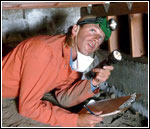Interest Rate Differentials and Your Mortgage
Wednesday, August 4th, 2010 Ever heard of Interest Rate Differentials, or IRDs? If you haven’t, and your mortgage contract contains a clause referring to it, you could end up with much, much less from the sale of your home in Spruce Grove, Stony Plain, Parkland County or the Edmonton area than you had anticipated.
Ever heard of Interest Rate Differentials, or IRDs? If you haven’t, and your mortgage contract contains a clause referring to it, you could end up with much, much less from the sale of your home in Spruce Grove, Stony Plain, Parkland County or the Edmonton area than you had anticipated.
I just re-read an email from Frank DeAngelis, a Spruce Grove lawyer (contact information below) who often handles the legal side of home sales and purchases for my clients. Although the email was written a year ago, its content and advice are just as relevant in today’s real estate market:
“In the last few months the Real Estate Department at Main Street Law Offices has dealt with some very surprised and upset Vendors relating to the amount of their mortgage pay-outs.
“Most Vendors seem to be expecting a three month interest penalty if they pay their mortgage out early. However, MOST mortgages call for a three month interest penalty or an interest rate differential (“IRD”), whichever is HIGHER. This higher cost effectively reduces the equity that Vendors have in their existing properties, making their next purchase difficult to complete as they were expecting more equity from the sale of the old house.
“IRDs can be substantial and are a current concern due to the large decreases in interest rates over the past year. For example, take a $300,000.00 five year mortgage taken out in 2007 at 6.5%. With current rates at 4% or less, the pay-out penalty today with three years remaining on the term is $300,000.00 X 2.5% X 3 = $22,500.00
“We strongly recommend that you insist on your clients getting an estimated pay-out statement from their banker, including the IRD pay-out, in any circumstances where reliance is being based on an estimate of equity in the sale property. This will help avoid closing surprises and assist us greatly in achieving ON TIME TM closings for your referrals.
“Sometimes the bankers can help resolve the issue by “porting” the mortgage. Each lender has different policies, so each case has to be addressed on its own merits. We suggest you involve the bankers early to see what they can do to make this issue less of an impact on closing.”
Frank C. DeAngelis, Barrister & Solicitor
MAIN STREET LAW OFFICES Barristers & Solicitors Box 3407, 115 Main Street Spruce Grove, Alberta T7X 3A7 PHONE: 780-960-8101 FAX: 780-962-3644

 “Location, location, location” usually means attractive neighbourhoods close to schools, hospitals, and facilities for entertainment, recreation and shopping. It can mean proximity to a lake or backing onto a park, green space or golf course. Homes in undesirable locations might be next to commercial/industrial buildings, beside railway lines, under flight paths, or in neighbourhoods with high crime rates. Also included are economically depressed areas, where neighbours show zero pride of ownership in maintaining their homes and yards.
“Location, location, location” usually means attractive neighbourhoods close to schools, hospitals, and facilities for entertainment, recreation and shopping. It can mean proximity to a lake or backing onto a park, green space or golf course. Homes in undesirable locations might be next to commercial/industrial buildings, beside railway lines, under flight paths, or in neighbourhoods with high crime rates. Also included are economically depressed areas, where neighbours show zero pride of ownership in maintaining their homes and yards. A good home inspector will spend between 2 to 4 hours (depending on the house size) inspecting the home. He or she should have equipment such as a moisture detector, carbon monoxide detector, ladders, magnifying glasses, mirrors and other specialized equipment in order to check all areas of the home and in cracks and crannies when needed. A thorough home inspection should give you a good overview of the general condition of the plumbing, electrical, roofing, insulation, windows, grading, drainage, the foundation where exposed, furnace, hot water tank, and general construction and condition of the home. It is advised that you be there for most of the inspection or at least the latter half of the inspection. That way you can see firsthand any deficiencies (minor or major) noted by the inspector. You can also ask the inspector to look more closely at any areas that are of concern to you.
A good home inspector will spend between 2 to 4 hours (depending on the house size) inspecting the home. He or she should have equipment such as a moisture detector, carbon monoxide detector, ladders, magnifying glasses, mirrors and other specialized equipment in order to check all areas of the home and in cracks and crannies when needed. A thorough home inspection should give you a good overview of the general condition of the plumbing, electrical, roofing, insulation, windows, grading, drainage, the foundation where exposed, furnace, hot water tank, and general construction and condition of the home. It is advised that you be there for most of the inspection or at least the latter half of the inspection. That way you can see firsthand any deficiencies (minor or major) noted by the inspector. You can also ask the inspector to look more closely at any areas that are of concern to you.
